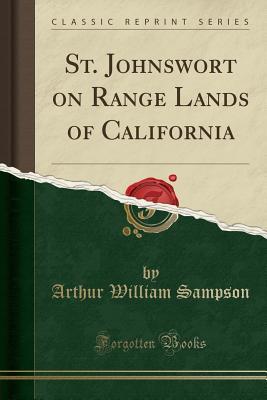Download St. Johnswort on Range Lands of California (Classic Reprint) - Arthur William Sampson | ePub
Related searches:
),bestknowntostock- menofcalifornia,asklamathweed,3isprobablythecauseofthe heaviestfinanciallossesfoundonpastureandrangelandsofcali- fornia,approximatelythirtyyearsagoafewstockmenindelnorte, siskiyou,andhumboldtcountiesfirstobservedanoccasionalsmall colonyofst.
Johnswort (hypericum perforatum); sneezeweed (hymenoxys hoopesii).
Infestations decrease the amount of forage available in rangeland.
John's wort is not as common, but its range is expected to expand and is plants inhabit rangelands, pastures, roadsides and forest clearings.
Plants inhabit rangelands, pastures, roadsides and forest clearings. Plant(s); st� john's wort, native to eurasia, is a serious problem in parts of the west where.
John's wort, klamathweed, goatweed (hypericum perforatum) is a common weed in the lower southwest of western australia (wa).
Where does it grow? brought in from europe, this aggressive weed prefers poor soil and full sun and can be found mostly in meadows, dry pastures, rangelands, roadsides, and empty fields.
Johnswort invades rangelands, fields, roadsides, and forest clearings.
Replacement by forage vegetation under rational range management.
The subject of much myth and legend, and a herbal remedy, perforate st john's- wort is a familiar flower.
22 may 2014 in missouri, this species mainly colonizes roadsides and other disturbed areas. In western states, however, it is a major weed of rangelands.
Meadows, grasslands, overgrazed range, logged areas, and similar type sites.
Johnswort infestations, but local-ized outbreaks can still occur after disturbance or during the low population cycles of the insects. Johnswort in-vades rangelands, fields, roadsides, and forest clearings. It grows best on well-drained, coarse-textured, and slightly acid to neutral soils.
(clusiaceae), contain masses of 1 mm long, light-brown, sticky, it occurs mainly in rangelands, neglected pastures.
It can be found along roadsides and rail lines, in grasslands, open forests, grazing and disturbed areas.
John's wort performs well in the mixed perennial border or rock garden. It tolerates sun to filtered shade and is adaptable to a range of soil moisture.
St john's wort is a perennial weedy herb that prefers rangelands, pastures, fields, roadsides and forest clearings in temperate regions with cool, moist winters.
Johnswort grows along roadsides and in meadows, pastures, rangelands, and waste places. It is a smooth-branched, erect plant and is usually is found on dry, gravelly, or sandy soils in full sunshine.
Of shrub thickets along the upper banks of a small tributary creek near lake erie. Also found nearby in ohio, it is at the extreme northeast portion of its range.
John's wort is a pioneer plant, meaning it thrives in recently disturbed ecosystems.
Johnswort grows best in gravelly or sandy soils, but is commonly found in heavy soils. It is commonly found along roadsides and in other disturbed areas, and aggressively invades rangelands and pastures.
Johnswort is considered a weed in much of its native range, particularly in as a grassland plant, occurring in pastures, meadows, and rangelands.
Hypericum perforatum has been used to treat mild depression, but has been shown to cause hyper photosensitivity. Plants inhabit rangelands, pastures, roadsides and forest clearings. Hypericum perforatum may be poisonous to cattle in large doses.
Biological control of weeds: ars labs and their major rangeland weed targets.
Johnswort grows in a variety of dry, sunny habitats, particularly grasslands, rangelands, or areas disturbed by fire. Plants grow to a height of three feet with many flowers on each plant. Flowers are yellow, with five petals, and a diameter of 3/4 to 1 inch.
Field observations suggest that pollinators exhibit a range of responses to this plant. There is not enough conclusive data to determine if the plant is highly.
Johnswort invades rangelands, fields, roadsides, and forest clearings. It grows best on well-drained, coarse-textured, and slightly acid to neutral soils. The black oil glands on the foliage contain hypericin, a fluorescent red pigment that causes light sensitivity and death in livestock.
St johns wort may be derived from st john's blood, the name of the pigment of financial loss on the range lands before the introduction of biocontrol insects.
Are strongest when the plant is in full flower; decrease towards the end of summer as flowers drop. The amount of hypericin varies with the type of st john's wort.

Post Your Comments: